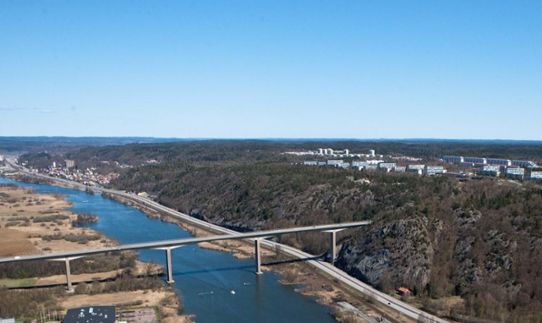Flood risk in the Göta River valley
The existing road along the Göta River has flooded at certain sections at regular intervals, leading to one lane having to be partly or entirely closed and, on some occasions, traffic had to be rerouted to local roads.
The flood risk along the section is mainly due to high water levels in the sea around Gothenburg, which limits run-off from Göta River. The sea level is the single most significant factor affecting the flood risk and in unfavourable conditions can affect the level in the river all the way up to the sluices in Lilla Edet. The high flows in the Göta River have less of an impact.

Raising of road and railway
Since the transport section is so important to both the daily work commute and the entire region’s future development, the authorities chose to place the road and railway higher than would have sufficed for a less important section where detours or short stops could have been accepted. The level of the railway was chosen slightly higher considering the greater consequences of flooding, e.g. the impact on electrical systems. The ultimate increase in elevation was up to 1.5 metres over current levels where the flood risk was the greatest.
Costs
The cost for the entire project “BanaVäg i Väst” was SEK 13.6 billion, which was financed by the Swedish Road Administration and the Swedish Rail Administration. A relatively large part of this sum, more than SEK 1 billion, was spent on geotechnical measures to limit subsidence and reduce the risk of flooding.
When the costs for different levels were compared, it was estimated that an elevation increase of half a metre, which can be linked to climate change, would end up at SEK 50-60 million. However, this figure only includes the raising of the railway of around 22 km between the Angeredsbron Bridge and Älvängen, the most flood sensitive section.
The project in the Göta River valley began as a collaborative effort between the former authorities the Swedish Road Administration and the Swedish Rail Administration and continued under the direction of the Swedish Transport Administration beginning in 2010. Both road and railway were finished in 2012.
More examples of climate adaptation
This is one of many examples of climate adaptation. There are more in the collection of ideas being built up by the Swedish National Knowledge Centre for Climate Change Adaptation at the Swedish Meteorological and Hydrological Institute (SMHI). The collection of examples has the aim of sharing experiences and providing ideas to everyone who works with climate adaptation. Examples describe concrete measures and challenges in several subject areas. They show how different actors have worked to adapt their activities to the climate changes that are already being noticed today and those that we cannot prevent in the future.